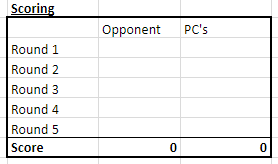But my players are only abstractly aware of the contextual problem-solving in older editions, so me sandbagging skills and abilities wholesale is like an amphibian saying to his fish buddy "Ok Jen we're gonna work on that air-breathing today!" and hurling her out of the lake.
The calamitous severity of this approach is self-evident.
I believe 5e combat places a burdensome opportunity cost on melee combatants who choose not to use the Attack action(s) on their turn. Compoundingly I find that having to burn your action to Disengage* tends to render static, process-oriented battlefields where the self-reinforcing order of operations
1. Close
2. Thwack
3. Repeat #2 until someone hits 0hp, then begin again at #1
recurses ad mortem for melee combatants. The game, in the bones of its arithmetic, rewards thwackers for this behavior.** To be fair, my players, lil sugarsnaps that they are, often find ways to diversify the potential tedium of a fight by thinking outside of their character sheets. And yeah while my tastes may run towards the gonzo, I don't want EVERY fight turning into a Cirque show at the MGM Grand.
So I'm fixin to try out these dynamic melee tables. The idea is that, based on the attacker's size relative to the target's size, the attacker will roll randomly for a dynamic effect if their to-hit roll exceeds the target's AC by 7 + the PC's proficiency bonus. If the attacker rolls a critical hit, they roll critical damage and get to pick which effect they want.
*How did disengaging or the equivalent work in past editions of dnd?
**tip of the cap, however, to the Fighter's Superiority Dice.
 |
| Kyle, no I don't-- KYLE, JESUS NO |
The calamitous severity of this approach is self-evident.
I believe 5e combat places a burdensome opportunity cost on melee combatants who choose not to use the Attack action(s) on their turn. Compoundingly I find that having to burn your action to Disengage* tends to render static, process-oriented battlefields where the self-reinforcing order of operations
1. Close
2. Thwack
3. Repeat #2 until someone hits 0hp, then begin again at #1
recurses ad mortem for melee combatants. The game, in the bones of its arithmetic, rewards thwackers for this behavior.** To be fair, my players, lil sugarsnaps that they are, often find ways to diversify the potential tedium of a fight by thinking outside of their character sheets. And yeah while my tastes may run towards the gonzo, I don't want EVERY fight turning into a Cirque show at the MGM Grand.
So I'm fixin to try out these dynamic melee tables. The idea is that, based on the attacker's size relative to the target's size, the attacker will roll randomly for a dynamic effect if their to-hit roll exceeds the target's AC by 7 + the PC's proficiency bonus. If the attacker rolls a critical hit, they roll critical damage and get to pick which effect they want.
If attacking creature is the same size as or bigger than target, and exceeds AC by [PC proficiency bonus + 7] or more
1. Target is pinned/stuck to something in the environment, must dislodge itself to move/attack on its next turn.
2. Target is tossed/pushed 5 ft from its current spot to an unoccupied spot, but remains standing. You pick where it goes.
3. Target is tossed/pushed 5 ft from its current spot to an unoccupied spot. Lands prone. You pick where it goes.
4. Target is flung/heaved into the air, landing 1d2 grids (or 5 - 10 ft) from current spot. Lands prone. You pick where it goes. Takes 1d6 bludgeoning damage.
5. Your melee attacks are so savage, you have discombobulated your target. If it has more than 0 hp, it has the Stunned condition until the start of its next turn.
6. You can add up to half your movement speed to your speed this turn, and use it now. You provoke no opportunity attacks on this turn.
7. You can take one more attack action on this turn.
8. You push, trip, or hurl target into one or more of its allies within 5 ft. This can either knock them both prone, cause 1d6 bludgeoning damage to both, or something along these lines.
9. ARTERY! 1d6 additional damage, and 1d6 damage rolled at the start of target's every turn unless it is healed magically or stanched with a DC12 Medicine (Wis) check.
10. Fearsome thwacks. Target is so shaken by your attacks that is gains the Frightened condition for 1d2 rounds.
If attacking creature is smaller than target and exceeds AC by [PC proficiency bonus + 7] or more
1. You can mount or otherwise climb onto your enemy.
2. You can trip, knock down, or otherwise hobble your enemy momentarily. It lands prone. [(CR/4)d6] damage
3. Your attack disorients your enemy -- move it to last in initiative order for the rest of the fight.
4. Through raw strength, magic, trickery, or cunning you cause your enemy to be pushed or move in a direction and facing of your choosing. It is not prone.
If I done my math right (and this is NEVER a sure thing), that means that a level 5 character with a +7 to-hit has a 25% chance of triggering a dynamic melee hit on an enemy with AC 13, 20% for AC 14, and so on. I haven't playtested this yet or even thought it through all that hard, but I'm gonna use these in my next session. If you read this and have a thought, leave a thought.
***
*How did disengaging or the equivalent work in past editions of dnd?
**tip of the cap, however, to the Fighter's Superiority Dice.








